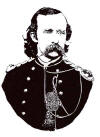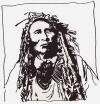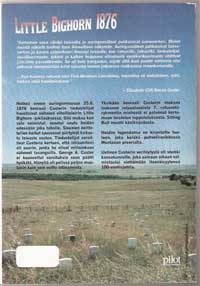| Friends Of The Little Bighorn Battlefield |
The Next Generation In The Study Of Custer's Last Stand |
Written In the Wind |
| • The Battle • Archeology • Memorials • Little Bighorn Store • News • Book Reviews |
An Interview With Jari TeilasWebmaster's Note: Jari Teilas and I have corresponded for over a year and Iím happy to report that his book regarding the Battle of the Little Bighorn will be published June 25, 2008. This is outstanding and a great accomplishment for Mr. Teilas because he is Finnish. His book is written in Finnish and Iíll admit since I do not speak Mr. Teilasís language, nor read it, I will not be able to review the book. The title of the book is KIRJOITETTUNA TUULEEN (Written in the Wind). Mr. Teilas is a wonderful example of how the story of Custerís Last Stand literally has neither borders nor a language that doesnít understand it. Jari has a great grasp of the English language, but for the record he asked me to rewrite his answers for clarity. I did as he requested, but he approved my translation. Iíd like to introduce to the Friends members and our readers, Mr. Teilas. All excerpts and illustrations from Written in the Wind, copyright by Jari Teilas and Pilot-kustannus Press. May 14, 2008 Bob Reece: Before we get to your book, please tell us about yourself: Jari Teilas: Iíd be happy to. My name is Jari Pekka Teilas. I live in Kotka with my wife Satu and son Onni (means happiness or luck). Kotka is in south-east of Finland, which is the biggest export harbor of Finland. I have an interesting career as a welder and carpenter making stage sets in the Kotka theater. B.R. Itís fascinating to always find someone from other than America that loves this story enough to write a book in their language. How did you become interested in the story of Custerís Last Stand? J.T. When I was a young boy, I watched the film ďThey Died with Their Boots OnĒ for the very first time on television. Errol Flynnís portrayal of Custer had an enormous impact on me. I had never heard of Custer or the Little Bighorn before seeing this movie. Still today, when I think of Custer in movies, I always think first of Errol Flynn. Of course, like most that study Custer, Iíve grown to know a different man. George Custer B.R. When did you realize you wanted to write a book on this subject and why? J.T. In the beginning, as I studied this story, I made simple notes for myself regarding people and events about the battle which I was interested in. Eventually, I shared those notes with members of a Finnish Western Society Ė on their website and in the Ruudinsavu-Magazine (Ruudinsavu translates as gun smoke). After many years, in 2007, I came to the realization that I had acquired a lot of valuable information about this subject. Enough that I believed I could write a book, in my language, for my countrymen. B.R. How did you manage to do your research? J.T. Of course, it was impossible for me to conduct any primary research living so far from the history. Instead, I purchased every book about Custer and the Battle of the Little Bighorn that I considered important. I also corresponded with many American historians, like you, by email. B.R. How long did you spend researching and writing the book? J.T. I began to take my study seriously by taking notes about six years ago in 2002. Iíve read over 60 books and 200 magazine articles. I almost slept with a book in my hands! The last year was consumed in writing and editing the book. B.R. Have you ever visited the battlefield and if so, please tell us about that experience. J.T. Unfortunately, I have never been able to visit there. Iíve made a promise to myself to travel there with my son Onni once he is old enough to appreciate the adventure. He is almost six now. Iím fortunate to have a friend who has been to the battlefield six times. He has told me so much about his fascinating travels there. He was very generous in allowing me full use of his personal photos of the battlefield that are seen in my book. There are 30-40 photos of terrain. B.R. That was smart, Jari, to use many photos of the terrain. Most people who read about this battle but have never visited the battlefield have a sudden awakening in their interpretation of it once they see the actual battlefield for the first time. Iíd love to hear about your experience after you visit the battlefield with your son Onni. How is your book presented? Do you cover more than just the Battle of the Little Bighorn? J.T. The book begins with the 7th Cavalry marching out of Ft. Lincoln on May 17, 1876. I tell the events day by day from the viewpoint of the 7th Cavalrymen and the scouts, specifically Mitch Bouyer and Lonesome Charlie Reynolds. The scouts are my personal favorite characters in my studies. I give an account of the military official history of the battle, as well as the Indian side of the story. Iíve also included a complete roster of 7th cavalrymen, and readers will find a list of about 400 warriors.
Wooden Leg
There is a list and minor biographies for all the Medal of Honor recipients. There is a biography for every officer in the battle, and of many soldiers, scouts, and warriors. I also look at popular culture regarding the movies about Custer, the artists who have painted the battle, and the historical photographs of the battlefield. I even have a chapter that covers the folklore of Custer and the battlefield. Readers will learn about the 50th anniversary events as well. The final chapter is dedicated to Sitting Bull and the New World apostles (Leonard Peltier, Russell Means, and Dennis Banks). Included is an appendix about the military organization of the 1876 army. Iíve illustrated the book myself. There are over 40 portraits. My wife helped me in making the maps (seven). And more and moreÖ
Map of Battle of the Little Bighorn
B.R. Jari, that is quite extensive and very impressive. What does the title mean to you? J.T. Nobody knows what exactly happened at the Battle of the Little Bighorn but the wind. I think that anybody who listens carefully to the wind on the prairie could find the answer to solve the mystery. B.R. What is your theory about how this battle evolved? In other words, how did Custer end-up on Last Stand Hill? J.T. I donít have any new theory about it. However, I believe that Custerís soldiers and horses were exhausted which was an important component for their defeat. As you can read from my response above, Written in the Wind is a collection of stories about the mystery of Custer and his defeat on the Little Bighorn. There is one thing that makes me wonder: why Custer with his men did not ride back from where they came once in Medicine Tail Coulee. He knew that Benteen and the pack train were coming from there. B.R. Iím not aware of any book regarding this subject published in Finnish before. Is yours the first? J.T. Yes, this is the first book. Some good magazine articles on the subject have been written, but not a book. Mine will be 400 pages. B.R. How does that make you feel? J.T. It feels very good, but Iím little bit afraid of how it will be received. B.R. What do you hope your audience will gain from your book? J.T. I donít pretend to have found the absolute truth of what happened along the Little Bighorn, but rather hope that my book will inspire readers to become interested in the battle as I did when I first watched ďThey Died with Their Boots OnĒ. B.R. Are there any plans to publish the book in English? J.T. How wonderful that would be. At the moment there are not any plans to publish it in English. B.R. What are your three favorite books on the Little Bighorn? - Little Big Horn Diary Ė Chronicle of the 1876 Indian War by James Willert. Iíve got a signed copy. Iím sure there is a bit of the spirit of Jim Willert in my copy. - The Custer Myth Ė A Source Book of Custeriana by Colonel W. A. Graham - Custerís Last Campaign Ė Mitch Boyer and the Little Bighorn Reconstructed by
John S. Gray Printed on the back cover "From the hour of breaking camp, before the sun was
up, a mist had enveloped everything. Soon the bright sun begun to penetrate this
veil and dispel the haze, and a scene of wonder and beauty appeared. The cavalry
and infantry in the order named, the scouts, pack mules, and artillery, all
behind the long line of white-covered wagons, made a column altogether some two
miles in length. As the sun broke through the mist a mirage appeared, which took
up about half of the line of cavalry, and thenceforth for a little distance it
marched, equally plain to the sight on the earth and in the sky." "Just before sunrise on June 25, 1876 the scouts of General Custer noticed a huge village of Indians in the Little Bighorn River valley. As the dawn broke, they could see more of the valley. The scouts warned Custer about the Indian village which was the biggest they had ever seen on the plains. Custer ignored their warning Ė he decided to attack. Not a single one of those who rode with Custer into the valley lived to tell their story of what really happened there. Sitting Bull wrote the book. All of their legends are written in the wind which whispers on the prairie of Montana. The news of the Custer massacre was a shock to the nation which was preparing to celebrate its Centennial." Books On The Horizon HomeMore Of Our Interviews With Historians |
|
||
|
Copyright 1999-2013 Bob Reece Friends Little Bighorn Battlefield, P.O. Box 636, Crow Agency, MT 59022 | Home |
Board of Directors |
Guest Book | Contact | Site Map
| |
|||





